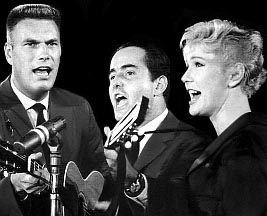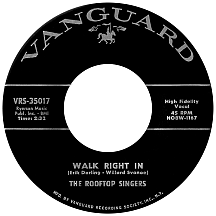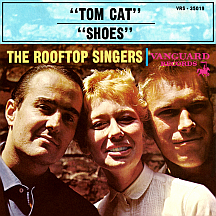THE ROOFTOP SINGERS
Walk Right In
Erik Darling had one of the most extensive resumés in folk music. A Baltimore native raised in upstate New York, as a teenager he lived with his mother in New York City, later forming The Folksay Trio with black singer Bob Carey and banjo player Roger Sprung. In 1953, when Erik was 20, the group made a few recordings for the Stinson label (including the 1920s tune "Tom Dooley," which famously established The Kingston Trio several years later). Carey and Darling played with a short-lived act, The Tunetellers, then recruited struggling (but future Oscar-winning) actor Alan Arkin for their new group The Tarriers. Two major hits on the Glory label resulted: the Tarriers backed 19-year-old singer Vince Martin on "Cindy, Oh Cindy," top 20 in late 1956, and they merged a pair of folk songs, "Banana Boat" and "Hill and Gully Rider," as "The Banana Boat Song," placing it in the top ten at the end of the year, just before Harry Belafonte's "Day-O" variation broke loose.
The Tarriers performed their "Banana Boat" hit in Calypso Heat Wave (29-year-old Maya Angelou appeared in the film as "Miss Calypso"), but the outfit split the following year when Darling was hired to replace Pete Seeger in the decade's top folk act, The Weavers. He was quite prolific; a seriously focused guitar player, Erik practiced endlessly and played on a great number of recording sessions in addition to his work with the Weavers. He left the act in June of 1962, determined to exercise more creative control over his art with a new set of like-minded partners. Lynne Taylor had sung in public as a teenager in Philadelphia; she had one single on Coral in 1956 (a novelty pop tune, "Rockroleville") and frequented jazz clubs during the 1950s, performing at popular nightspots like the Village Vanguard in Greenwich Village and Birdland in the heart of N.Y., in addition to singing for the Benny Goodman and Buddy Rich bands in '57 and '58. Darling justly reasoned her presence would add depth. Bill Svanoe, a guitarist, singer and well-traveled civil rights activist, played an equally important role in the group, serving as a counterpart to the instrumental sound Darling planned to implement.
The formation of The Rooftop Singers (who could just as easily have been called "The Fire Escape Singers," as evidenced by the photo on one of their album covers) was built around the use of the 12-string guitar, an obsession of Erik's at the time. A blues song he'd wanted to adapt to a 12-string arrangement provided motivation. Mississippi-born banjo player Gus Cannon had gone by the name Banjo Joe in the 1920s; Hosea Woods, who played guitar, banjo and kazoo, joined his band, Cannon's Jug Stompers, and the group recorded Hosea's "Walk Right In," issued on Victor in 1930. The lyrics could easily be interpreted as an invitation to imbibe or inhale ('Walk right in, set right down...daddy let your mind roll on,' with the well-intentioned question: '...do you wanna lose your mind?'), various types of inebriation being among the more common themes in blues songs of the pre-World War II era.
The Rooftop Singers' remake of the song, recorded in the fall of 1962 for the Vanguard label, featured Erik and Bill playing two 12-string Gibson guitars simultaneously, creating a denser-than-usual sound not typically heard; the three sang in unison, though Lynne's formidable vocal ability overshadowed her two colleagues. The record's singular sound gained attention and it climbed rapidly up the charts, making a move from outside the top ten to number one in a single week in January 1963. The Walk Right In LP utilized a pair of seasoned jazz musicians, bassist Wendell Marshall and drummer Bobby Donaldson, to back the singers in the studio...not surprising for a hit song so different from any of the other folk singles of recent years...or ever. The album picked up a Grammy nomination for Best Folk Recording, not surprisingly losing to Peter, Paul and Mary's Bob Dylan-penned "Blowin' in the Wind" single.

Gus Cannon, still spry at age 79, was making the rounds and capitalizing on the big revival of the song he'd introduced. In June he took his banjo to the Stax studio in Memphis and made his first recordings in many years, doing it old-school with accompaniment from Will Shade on jug and Milton Roby on washboard; the album's title track, of course, was "Walk Right In." Erik, Lynne and Bill had by that time enjoyed a top 20 follow-up, "Tom Cat," considered cute by some and too suggestive by others (when Ringtail Tom and Little Pussy Cat '...start rousin' around,' I suppose that can only mean one thing!). The song was written by the three singers with Tom Geraci, who'd performed on New York streets as a duo with Erik in the early '50s and had briefly been a member of the Rooftop Singers at the start. In July '63 the hitmaking trio headed to Rhode Island to take the stage at the Newport Folk Festival, hobnobbing with the likes of not-yet-major-stars Joan Baez and Dylan. "Mama Don't Allow" had a nice chart run late that summer, but subsequent singles faltered.
Lynne called it quits and was replaced by Mindy Stewart, who sang on the 1965 single and album "Rainy River," the act's Vanguard swan song. Mindy was gone by '67 and Pat Street took her place; they were in-and-out at Atco Records with a single, "Kites," released late in the year before the group broke up for good. Street and Erik Darling worked together off-and-on into the 1970s. Bill Svanoe married Erik's ex-wife, Joan Darling, an accomplished television director, writer and actress; Bill followed her into the medium, first with a few small acting roles, then as a writer for TV series and movies. "Walk Right In" remains a familiar song via its use in films and TV ads; innovative use of the 12-string guitar is, perhaps, the main thing The Rooftop Singers will ultimately be credited with, having inspired others to explore its possiblities in pop and rock as musical horizons explanded throughout the 1960s and beyond.



